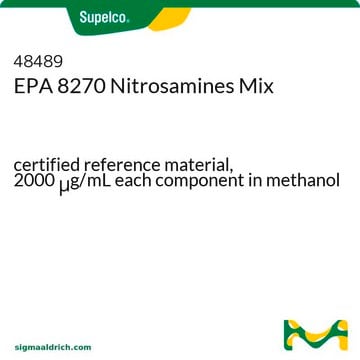B8061
N-Butyl-N-(4-hydroxybutyl)nitrosamine
ISOPAC®, ≥90% (GC)
Sinonimo/i:
BBN, N-Butyl-N-butan-4-ol-nitrosamine, N-Butyl-N-nitroso-4-aminobutanol
About This Item
Prodotti consigliati
Saggio
≥90% (GC)
Forma fisica
liquid
Temperatura di conservazione
2-8°C
InChI
1S/C8H18N2O2/c1-2-3-6-10(9-12)7-4-5-8-11/h11H,2-8H2,1H3
DIKPQFXYECAYPC-UHFFFAOYSA-N
Applicazioni
Azioni biochim/fisiol
Confezionamento
Avvertenza
Ricostituzione
Note legali
Avvertenze
Danger
Indicazioni di pericolo
Consigli di prudenza
Classi di pericolo
Acute Tox. 4 Oral - Carc. 1B
Codice della classe di stoccaggio
6.1C - Combustible acute toxic Cat.3 / toxic compounds or compounds which causing chronic effects
Classe di pericolosità dell'acqua (WGK)
WGK 3
Punto d’infiammabilità (°F)
296.6 °F
Punto d’infiammabilità (°C)
147 °C
Dispositivi di protezione individuale
Eyeshields, Faceshields, Gloves, type ABEK (EN14387) respirator filter
Certificati d'analisi (COA)
Cerca il Certificati d'analisi (COA) digitando il numero di lotto/batch corrispondente. I numeri di lotto o di batch sono stampati sull'etichetta dei prodotti dopo la parola ‘Lotto’ o ‘Batch’.
Possiedi già questo prodotto?
I documenti relativi ai prodotti acquistati recentemente sono disponibili nell’Archivio dei documenti.
I clienti hanno visto anche
Il team dei nostri ricercatori vanta grande esperienza in tutte le aree della ricerca quali Life Science, scienza dei materiali, sintesi chimica, cromatografia, discipline analitiche, ecc..
Contatta l'Assistenza Tecnica.










![9-Borabicyclo[3.3.1]nonane solution 0.5 M in THF](/deepweb/assets/sigmaaldrich/product/structures/180/891/8b64e597-269d-4780-98b6-40889dfd06b9/640/8b64e597-269d-4780-98b6-40889dfd06b9.png)
